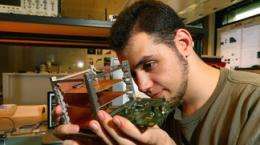Pico-satellites have a new brain on board

For his Master's thesis in microengineering, Louis Masson designed a new microcomputer for use in pico-satellites. His invention will improve the satellites' ability to manage complex data.
His research results fit on a card that's barely ten centimeters square. But this thin electronic mesh will give the next generation of pico-satellites a distinct advantage – they'll have a new "brain." For his master's thesis Louis Masson chose to make a central microcomputer to ride aboard Cubesat-type satellites, small satellites in the form of a 10cm cube, with a 1L volume and weighing under 1.33 kg.
This satellite model, invented at the start of the 2000s by Caltech and Stanford University, was designed primarily to allow scientists from around the world to carry out less expensive experiments in space. In cooperation with several Swiss Universities of applied science and the University of Neuchâtel, EPFL developed its own pico-satellite, SwissCube, which was launched in 2009.
"My goal is to create a more reliable architecture than the one on SwissCube for one of the satellite's most important systems, the "Command and Data Management Subsystem" or CDMS," explains Masson. "The idea is to improve the performance of SwissCube-type satellites. This new generation will be capable of managing more complex data and will have access to more computing power. It could, for example, control its positioning on several axes, not just self-stabilize."
The CDMS manages and coordinates all the commands. It receives ground-based commands and relays them to the satellite's other systems, which manage communications, positioning, energy supply and data collection. It also stores scientific or basic information such as temperature, position, and the satellite's speed, gathering it all together and then transmitting it back to Earth.
A happy marriage
One of the Swiss Space Center's ideas was to fuse the CDMS with the system in charge of controlling the satellite's position in space, the "Attitude Determination and Control Subsystem" or ADCS. "This coupling allows a continuous exchange of information between the two systems and thus more precise control over the satellite," says Masson. In addition, as each has its own set of sensors, they ensure a redundancy that SwissCube did not already have. This means that if one set of sensors fails, the other can take over. This invention will thus make the SSC's future pico-satellites more resilient and reliable.
Provided by Ecole Polytechnique Federale de Lausanne


















